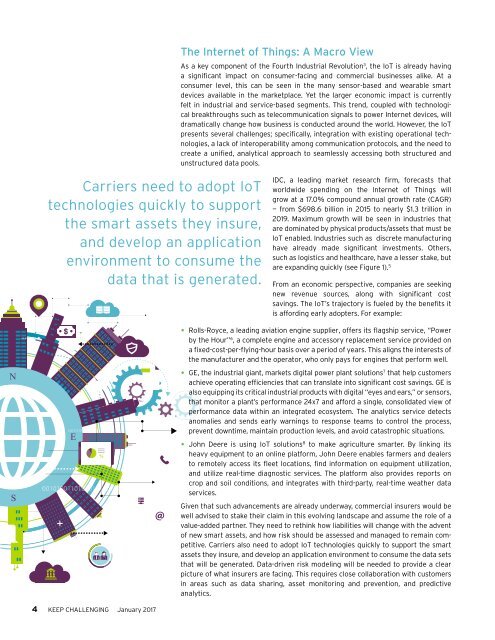Optimizing the Internet of Things Key Strategies for Commercial Insurers
optimizing-the-internet-of-things-key-strategies-for-commercial-insurers-codex2295
optimizing-the-internet-of-things-key-strategies-for-commercial-insurers-codex2295
You also want an ePaper? Increase the reach of your titles
YUMPU automatically turns print PDFs into web optimized ePapers that Google loves.
The <strong>Internet</strong> <strong>of</strong> <strong>Things</strong>: A Macro View<br />
As a key component <strong>of</strong> <strong>the</strong> Fourth Industrial Revolution 3 , <strong>the</strong> IoT is already having<br />
a significant impact on consumer-facing and commercial businesses alike. At a<br />
consumer level, this can be seen in <strong>the</strong> many sensor-based and wearable smart<br />
devices available in <strong>the</strong> marketplace. Yet <strong>the</strong> larger economic impact is currently<br />
felt in industrial and service-based segments. This trend, coupled with technological<br />
breakthroughs such as telecommunication signals to power <strong>Internet</strong> devices, will<br />
dramatically change how business is conducted around <strong>the</strong> world. However, <strong>the</strong> IoT<br />
presents several challenges; specifically, integration with existing operational technologies,<br />
a lack <strong>of</strong> interoperability among communication protocols, and <strong>the</strong> need to<br />
create a unified, analytical approach to seamlessly accessing both structured and<br />
unstructured data pools.<br />
Carriers need to adopt IoT<br />
technologies quickly to support<br />
<strong>the</strong> smart assets <strong>the</strong>y insure,<br />
and develop an application<br />
environment to consume <strong>the</strong><br />
data that is generated.<br />
IDC, a leading market research firm, <strong>for</strong>ecasts that<br />
worldwide spending on <strong>the</strong> <strong>Internet</strong> <strong>of</strong> <strong>Things</strong> will<br />
grow at a 17.0% compound annual growth rate (CAGR)<br />
— from $698.6 billion in 2015 to nearly $1.3 trillion in<br />
2019. Maximum growth will be seen in industries that<br />
are dominated by physical products/assets that must be<br />
IoT enabled. Industries such as discrete manufacturing<br />
have already made significant investments. O<strong>the</strong>rs,<br />
such as logistics and healthcare, have a lesser stake, but<br />
are expanding quickly (see Figure 1). 5<br />
From an economic perspective, companies are seeking<br />
new revenue sources, along with significant cost<br />
savings. The IoT’s trajectory is fueled by <strong>the</strong> benefits it<br />
is af<strong>for</strong>ding early adopters. For example:<br />
• Rolls-Royce, a leading aviation engine supplier, <strong>of</strong>fers its flagship service, “Power<br />
by <strong>the</strong> Hour” 6 , a complete engine and accessory replacement service provided on<br />
a fixed-cost-per-flying-hour basis over a period <strong>of</strong> years. This aligns <strong>the</strong> interests <strong>of</strong><br />
<strong>the</strong> manufacturer and <strong>the</strong> operator, who only pays <strong>for</strong> engines that per<strong>for</strong>m well.<br />
• GE, <strong>the</strong> industrial giant, markets digital power plant solutions 7 that help customers<br />
achieve operating efficiencies that can translate into significant cost savings. GE is<br />
also equipping its critical industrial products with digital “eyes and ears,” or sensors,<br />
that monitor a plant’s per<strong>for</strong>mance 24x7 and af<strong>for</strong>d a single, consolidated view <strong>of</strong><br />
per<strong>for</strong>mance data within an integrated ecosystem. The analytics service detects<br />
anomalies and sends early warnings to response teams to control <strong>the</strong> process,<br />
prevent downtime, maintain production levels, and avoid catastrophic situations.<br />
• John Deere is using IoT solutions 8 to make agriculture smarter. By linking its<br />
heavy equipment to an online plat<strong>for</strong>m, John Deere enables farmers and dealers<br />
to remotely access its fleet locations, find in<strong>for</strong>mation on equipment utilization,<br />
and utilize real-time diagnostic services. The plat<strong>for</strong>m also provides reports on<br />
crop and soil conditions, and integrates with third-party, real-time wea<strong>the</strong>r data<br />
services.<br />
Given that such advancements are already underway, commercial insurers would be<br />
well advised to stake <strong>the</strong>ir claim in this evolving landscape and assume <strong>the</strong> role <strong>of</strong> a<br />
value-added partner. They need to rethink how liabilities will change with <strong>the</strong> advent<br />
<strong>of</strong> new smart assets, and how risk should be assessed and managed to remain competitive.<br />
Carriers also need to adopt IoT technologies quickly to support <strong>the</strong> smart<br />
assets <strong>the</strong>y insure, and develop an application environment to consume <strong>the</strong> data sets<br />
that will be generated. Data-driven risk modeling will be needed to provide a clear<br />
picture <strong>of</strong> what insurers are facing. This requires close collaboration with customers<br />
in areas such as data sharing, asset monitoring and prevention, and predictive<br />
analytics.<br />
4 KEEP CHALLENGING January 2017


